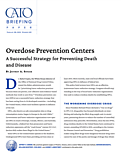As deaths from drug overdoses and drug-related diseases continue increasing, policymakers in cities across the United States have become more willing to consider implementing overdose prevention centers (OPCs) as the next step toward a more effective harm reduction strategy. For more than 30 years, OPCs have prevented overdose deaths, HIV and hepatitis, and other diseases and helped people with substance use disorder find treatment. OPCs, also known as safe consumption sites or drug consumption rooms, began in Europe in the mid-1980s. Governments and harm reduction organizations now operate OPCs in 16 developed countries, including many European countries, Canada, Mexico, and Australia. Unfortunately, a federal law that prosecutors and harm reduction opponents call the “crack house” statute makes them illegal in the United States. Yet New York City sanctions two such facilities in defiance of federal law.
Joining us to discuss the worldwide experience with OPCs, and to share data and experiences at sanctioned OPCs in North America, are Chelsea Boyd, research fellow in the R Street Institute’s integrated harm reduction program; Darwin Fisher, Senior Program Manager at PHS Community Services Society in Vancouver, British Columbia, and manager of Insite, North America’s oldest sanctioned overdose prevention center; and Kailin See, Senior Director of Programs for OnPoint NYC and program and development lead for New York City’s two sanctioned overdose prevention centers, the first approved OPCs in the United States. Cato Institute senior fellow Jeffrey A. Singer will moderate the discussion.






